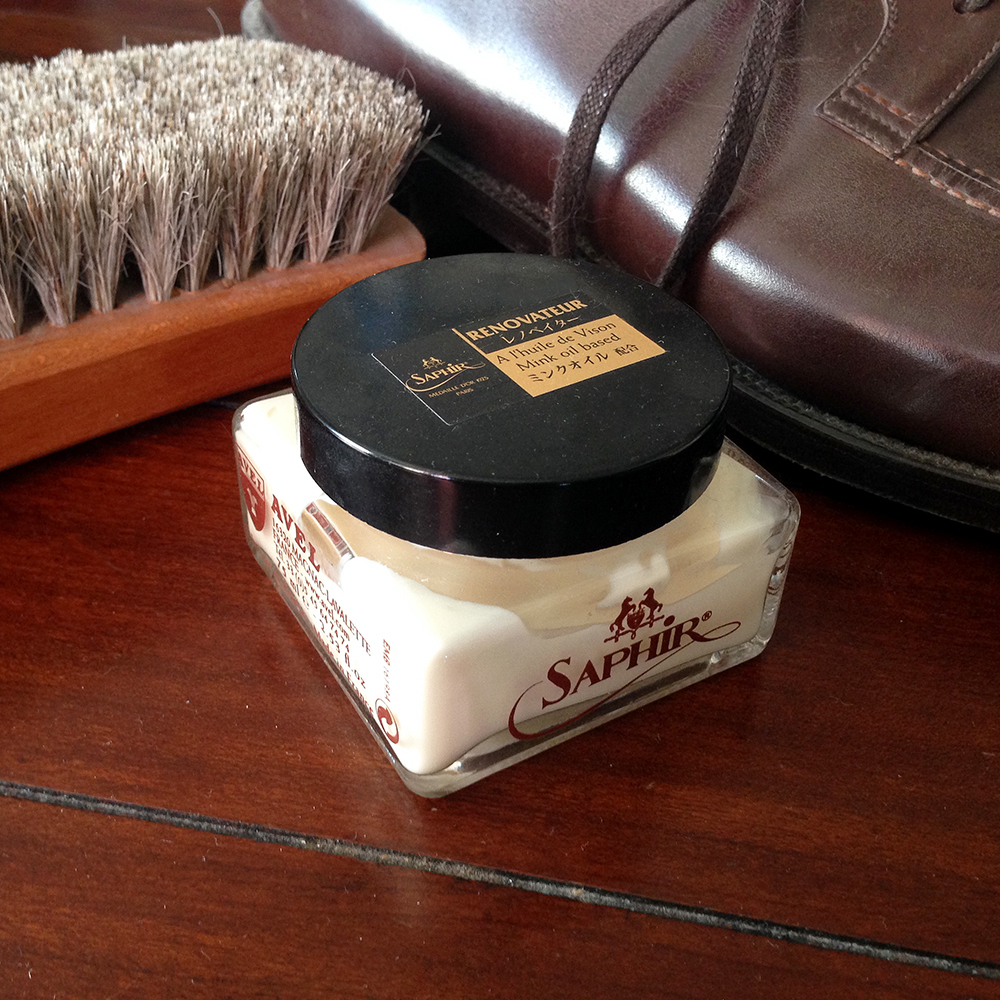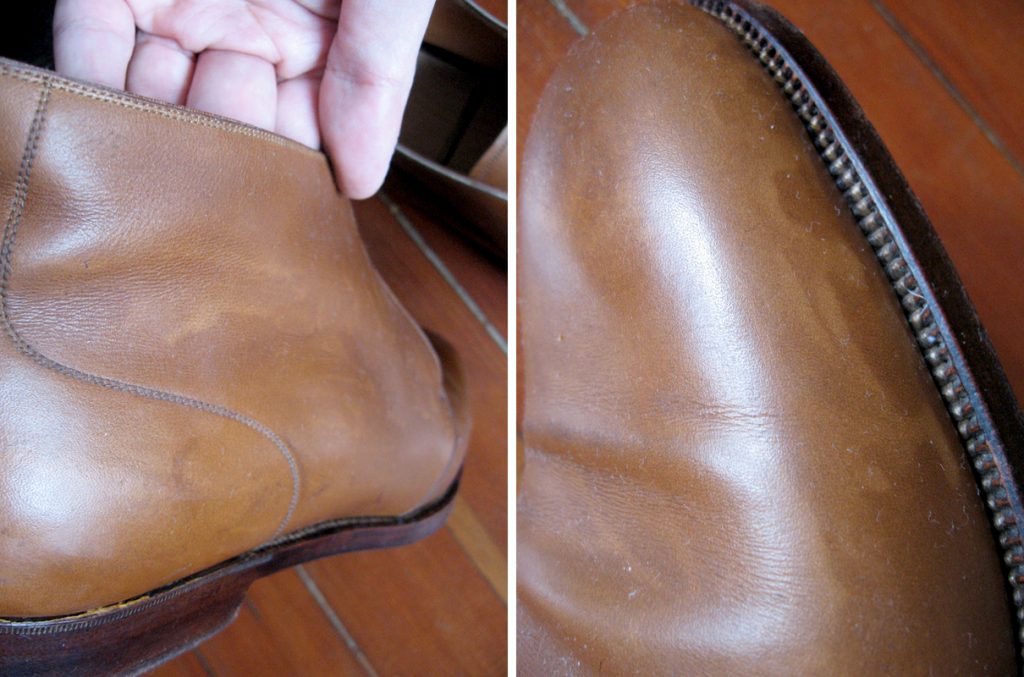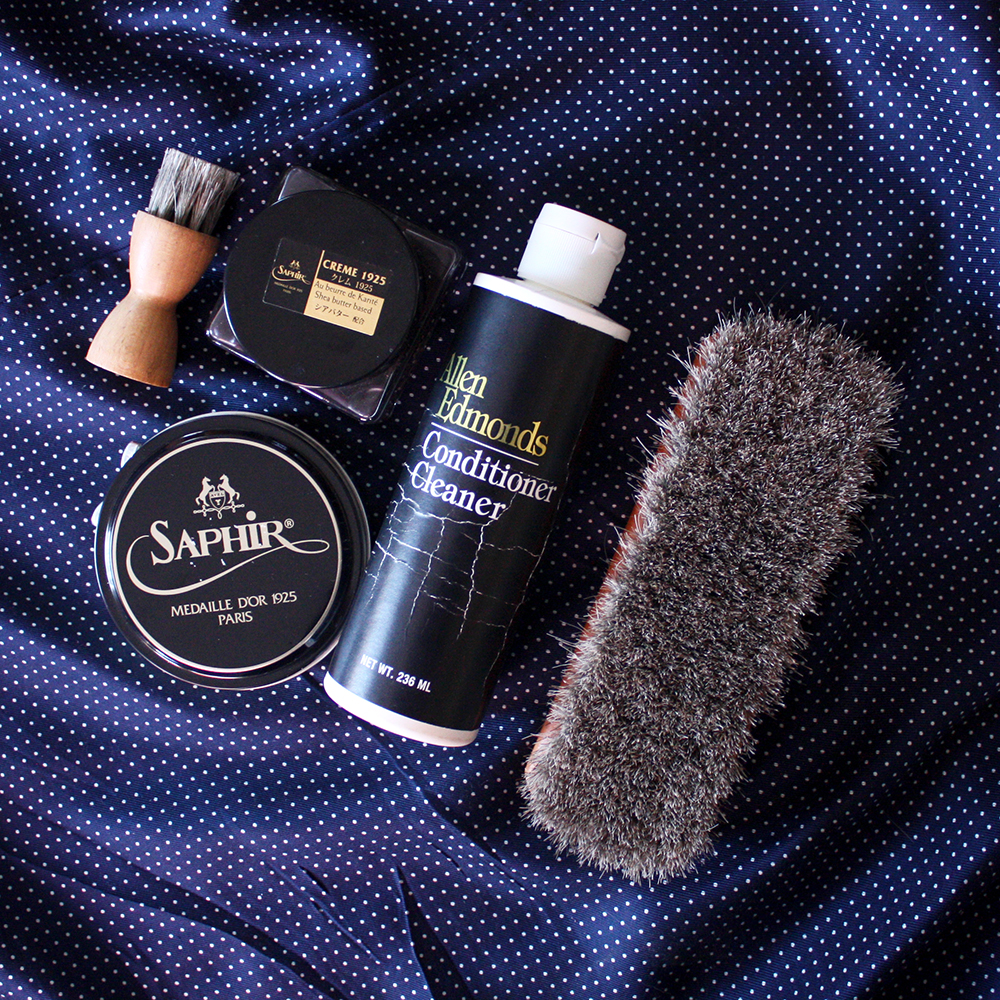
Saphir’s Medaille d’Or Renovateur has been called “liquid gold.” Men who are obsessive about their shoes often recommend it as the best all-purpose leather conditioner and cleaner. It’s a creamy white lotion that comes in a stout glass jar, smells vaguely sweet, and looks more like a high-end skincare product than something you would slather on your shoes. At $25 for a bottle, it’s also much more expensive than other conditioners and cleaners, but I imagine that’s part of the appeal. If you’re spending more than $300 for shoes, you probably enjoy knowing you’re getting nothing but the best.
My experience with Renovateur has been much less positive. About five years ago, I was applying some on my Saint Crispin’s chukkas when the doorbell rang. I went to answer my door and then returned to my living room a few minutes later. After a few quick wipes with a soft polishing cloth, I was surprised to see the color almost disappearing from my uppers. The leather looked splotchy and had a slightly tacky surface. In the photos below, you can see how the color almost looks like it dripped off.
I ended up sending the shoes back to Saint Crispin’s for repair. They’re located in Romania, and with the repair cost plus shipping fees, I paid somewhere in the neighborhood of $300. On the upside, they did a fantastic repair job, and the boots came back to me looking almost brand new.
About a year later, I bumped into Phillip Car, owner and director of Saint Crispin’s, at a trunk show in San Francisco. I reminded him of the incident, and he said he recommends against using Renovateur on his company’s shoes. “The stuff is kind of harsh,” he said. “You can condition the shoes with just a good cream polish. If it has enough oils in it, the oils from the polish will nourish the leather. There’s almost no need to use a leather conditioner on our shoes, but especially Renovateur.”

No one knows what’s in Renovateur. Like other shoe care products, the formula is a closely guarded company secret. But the label does say the conditioner is based in mink oil, which is a controversial compound. Some mink oil products on the market contain a high percentage of synthetics, which can clog up the pore of your uppers (Renovateur, however, is likely all-natural). Others say that it’s best kept to work boots, as it helps soften leather, and is not to be used on fine dress shoes. Others still say that it degrades stitching. Honestly, who knows.
I do know this: since my experience five years ago, I’ve seen maybe about a half dozen other cases on StyleForum pop up, where people have complained about the same thing. In every case, the person’s shoes are made from crust leather, which is an unfinished, unsealed leather that’s colored at the manufacturer’s factory using dyes. Companies use crust leather for a couple of reasons. For one, crust leather can result in a unique patina as the color wears away slightly unevenly (think of it like faded blue jeans). On the downside, to keep it looking its best, you often have to brush and polish it more often. Secondly, manufacturers use it because it can help cut down on their marginal costs. Instead of ordering 800 brown leather hides and 200 black leather hides, they can order 1,000 unfinished hides and color them however they want — black, brown, tan, burgundy, and even dazzling purple. This way, they can get a better bulk price on their hides and color things as they need, depending on orders, which results in less waste.
It used to be that you’d only ever see crust leather on the higher-end of the market, such as shoes from Paolo Scafora and Saint Crispin’s. In the last few years, however, I’ve been surprised to see it show up in more affordable ranges. Companies such as Carlos Santos and Paul Evans, for example, have used crust leather in the past. This is one of the reasons is why we recommended against using Renovateur in our “menswear essentials” guide — some guys may be wearing crust leather without even knowing it. Renovateur is generally fine on more traditional aniline or vegetable-tanned leathers. But if your shoes are made from crust leather, it can strip some of the color right off. In those cases, you’ll have to send the shoes to someone for repair (ideally, the workshop that colored the leather in the first place). You’ll also have to go a couple of shades darker than your shoes’ original color to cover up the damage. Even then, good results are not guaranteed.

How do you know if your shoes are made from crust leather? You can ask the company that sold you the shoes. Or, better yet, just don’t use Renovateur. You can condition your shoes using the following options:
- Use Saphir’s Shoe Polish. Kirby Allison over at The Hanger Project has a video showing the difference between Saphir’s shoe polishes over the company’s competitors. To be clear, he sells the stuff, so he has a vested interest. But his demonstration is about the best I’ve seen for why someone may want to splurge on Saphir’s shoe polishes, over the cheaper, more common varities you can find at your local shoe repair shop. Saphir’s polishes are oilier and penetrate more into the leather, which can help nourish the leather before you even need to use conditioner. Phillip Car recommended only using Saphir’s polishes on his company’s shoes. Nicholas Templeman, a London-based bespoke shoemaker who trained at John Lobb of St. James, tells me he also relies on the stuff. By using Saphir’s polishes, you may need to use a conditioner less often.
- Use Bickmore’s Bick 4. For your actual leather conditioner, pick up a bottle of Bickmore’s Bick 4, which is safe across a broader range of leathers. It’s famous for not darkening lighter colored leathers (although it may still darken crust since it’s unsealed), and it’s reasonably cheap at just $10 a bottle. Bespoke bootmaker DW Frommer swears by the stuff.
- Use Allen Edmonds’ Leather Lotion. This one comes with a caveat. I’ve been using Allen Edmonds’ Leather Lotion for more than a decade without incident. Last year, however, the company was sold to Cabelas. Their Leather Lotion now comes in a new bottle, but I wasn’t able to confirm with the company if their actual formulation has changed or just the packaging. That said, when my bottle is used up, I’ll probably get a new one, so I’ll continue to recommend it. The stuff is cheap, safe to use, and readily available online or at your local Allen Edmonds retail location.
- Use Saphir’s Leather Balm. Raul Ojeda of Willie’s Shoe Service, one of our favorite shoe repair shops in the US, says that his conditioner of choice is Saphir’s Leather Balm. It’s a little gentler than Renovateur. However, since crust leather is the stage of leather before it’s stained and sealed, he recommends switching up your shoe care routine if you’re indeed working with it. Instead of a regular conditioning and then polish, he suggests polishing first with a bit of wax and then applying some of Saphir’s Leather Balm. “You still want to test it on an inconspicuous spot first” he adds.







